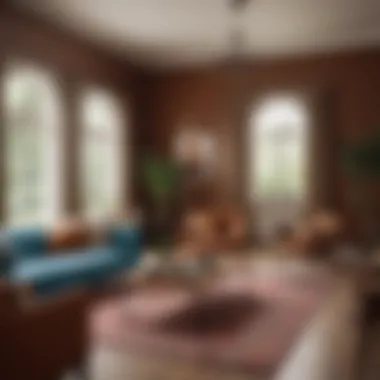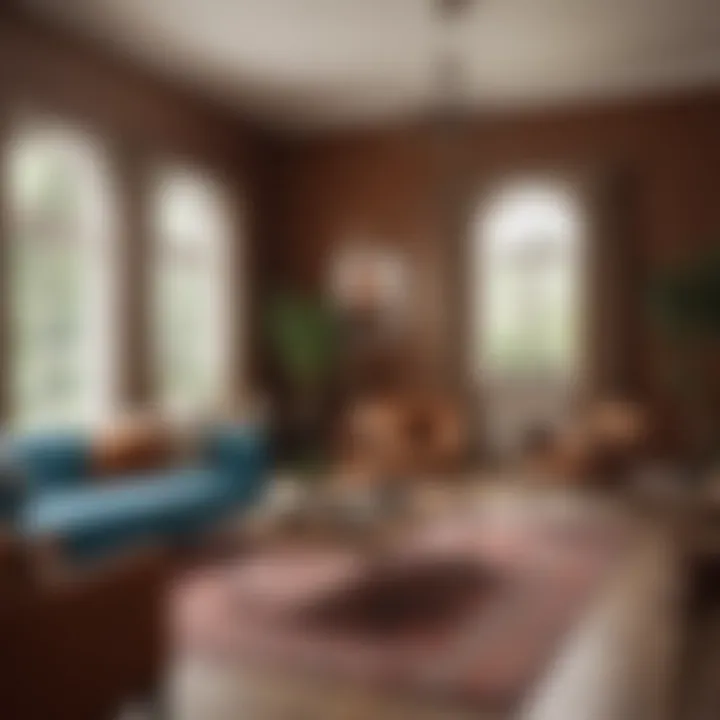Optimal Color Choices for Living Rooms with Brown Furniture


Intro
Choosing the right colors for a living room that features brown furniture can elevate the aesthetic of the space considerably. The color palette you select influences the overall mood and perceived size of a room. Brown, as a base element in furniture, offers warmth and versatility. However, pairing it with the optimal hues can make all the difference. Understanding these dynamics is essential for creating a living room that is both visually appealing and harmonious.
Design Inspiration
Current Interior Design Trends
Today’s interior design world leans toward a blend of minimalism and maximalism. Color choices often reflect these trends, influencing how brown elements can be showcased. The trend includes soft neutrals, earthy tones, and occasional bursts of color, often serving as focal points. Popular choices include shades like sage green or muted navy blue. These colors work well with brown, offering contrast without overwhelming the natural warmth the furniture provides.
Color Palettes and Their Effects
When integrating colors with brown furniture, several palettes can be considered.
- Earthy Tones: Colors like terracotta, olive green, and mustard enhance the natural aspect of brown. They contribute to a calming atmosphere.
- Cool Shades: Blues and grays can provide a modern touch. Soft blues evoke tranquility, while darker tones add sophistication.
- Warm Contrasts: Consider shades of red or peach for a vibrant contrast. These colors can create an inviting and energetic space.
- Monochromatic Scheme: Utilizing different shades of brown can create depth. This approach relies on variations in color rather than introducing new hues.
Choosing the right palette enhances not just aesthetics but also sets the emotional tone of the living room.
Ending
By understanding the interplay between brown furniture and various color options, homeowners can create a living room that feels both inviting and stylish. Whether opting for earthy tones or striking contrasts, the right color strategy will bring out the best in brown elements. Integrating personal taste with current trends can further refine your choices and result in a space that reflects your unique style.
Understanding Brown Furniture in Interior Design
Brown furniture holds significant importance in interior design due to its timeless appeal and ability to blend seamlessly with various decor styles. It embodies warmth and earthiness, which can transform a living space into a cozy retreat. This section highlights specific elements, such as the versatility and adaptability of brown furniture, the various styles that commonly feature it, and the benefits that come along with incorporating it into a living room.
The Versatility of Brown
Brown, as a color, offers great versatility. It comes in a wide range of shades including light beiges, deep chocolates, and rich mahogany tones. This diverse spectrum allows homeowners to choose the shade that best fits their style and the overall atmosphere they wish to create in their living rooms. Moreover, brown easily pairs with numerous colors, making it a practical choice for those looking to experiment with different palettes.
One of the key benefits of brown furniture is its ability to serve as a neutral backdrop. This characteristic enables other colors and decor elements to stand out, fostering a more dynamic visual experience. As such, it allows greater flexibility in choosing accent pieces, such as cushions, rugs, or wall art, ensuring liveliness in the design.
In addition to aesthetics, brown furniture is often associated with durability and resilience. Materials like wood, leather, and even certain fabrics in brown tones tend to be robust, promising longevity in an eclectic living room environment. This aspect is especially appealing to homeowners who prioritize practicality alongside looks.
Common Styles Featuring Brown Furniture
Numerous interior design styles embrace brown furniture, showcasing its adaptability. Here are some common styles:
- Traditional: This style often features dark-stained wooden pieces, creating a rich and classic atmosphere. The deep tones of the furniture can be complemented with warm palettes, enriching the overall design.
- Rustic: Rustic styles capitalize on raw materials and natural elements. Here, brown furniture harmonizes beautifully with textures like distressed wood, stone, and woven fabrics.
- Modern: In modern designs, brown furniture can provide a striking contrast when included alongside more contemporary elements such as sleek lines and minimalistic designs.
- Bohemian: Bohemian styles benefit from the warmth of brown furniture, as it serves as a quintessential base for layers of vibrant colors and patterns, allowing for a relaxed and eclectic space.
By understanding the multitude of styles that feature brown furniture, homeowners can make more informed choices about their furnishings. It allows them to envision how different looks will complement each other, ultimately leading to a more cohesive and inviting living environment.
The Psychology of Color in Living Spaces
Understanding the psychology of color is essential in the context of creating inviting and harmonious living spaces. Colors do not just beautify a room; they evoke emotions and set the atmosphere. When brown furniture is involved, the choice of color becomes crucial, as it can either complement or clash with the earthy tones of the brown elements. Adding the right colors can enhance comfort and warmth, making a space feel more like home.
A well-thought-out color scheme can transform the mood of a room. Consideration of color psychology can help homeowners and designers create an environment that is not only aesthetically pleasing but also feels good to live in.
Impact of Color on Mood and Atmosphere
Colors influence not only what we see but also how we feel. For instance, warm colors like red, orange, and yellow tend to invoke feelings of warmth and happiness. These shades can create a vibrant and lively atmosphere, perfect for social gatherings or family time in a living room. In contrast, cool colors such as blue and green can instill a sense of calm and tranquility, making them ideal for relaxation.
The interaction of these colors with brown furniture can change the overall vibe of the room. For example, pairing brown with warm tones can produce a cozy and inviting feel. Conversely, combining brown with cooler hues might provide a modern and sophisticated environment. Understanding how different colors work together with brown elements can lead to intentional and tailored designs that resonate personally.
"Choosing the right color can emotionally impact the experience of any living space."
Color Theory Basics
Basic principles of color theory guide how colors mix and how they are perceived in relation to one another. The color wheel is a helpful tool that categorizes colors into primary, secondary, and tertiary groups, aiding in the selection of complementary palettes.
Key concepts include:
- Complementary Colors: These are colors located opposite each other on the color wheel, creating a high contrast and vibrant look when used together. For example, pairing a rich brown with a vibrant turquoise can energize the space.
- Analogous Colors: These are colors that sit next to each other on the wheel, offering a cohesive and harmonious effect. Colors like beige and cream can pair seamlessly with brown, creating a soothing environment that feels visually balanced.
- Monochromatic Schemes: Using different shades of a single color can add depth while maintaining simplicity. A range of taupes or beiges can enhance the richness of brown furniture without overwhelming the senses.
With these principles, one can strategically select shades and hues that will both complement and uplift the overall aesthetic of living spaces. By considering how these colors impact mood, one can design a home that feels welcoming, calming, or energizing, depending on individual needs.
Complementary Colors for Brown Furniture
Brown furniture can serve as a foundation for a range of color choices in a living room. The complementary colors selected can enhance the aesthetic appeal and create a cohesive ambiance. Understanding how to choose complementary colors is essential for homeowners and interior design enthusiasts. This section will delve into the aspects of warm and cool color palettes, helping to frame your space in a manner that works well with brown elements.
The importance of finding the right color combination cannot be overstated. Complementary colors create balance and harmony within a room. They can influence the mood and perception of space, making it feel either more inviting or more stark. Consider painting walls to match or complement brown tones, using shades that resonate with the furniture while reflecting personal taste.
Warm Color Palettes
Warm color palettes typically include shades like red, orange, and yellow. These colors evoke feelings of warmth and comfort, making them suitable for spaces designed for relaxation and social interaction. When considering warm colors for a living room with brown furniture, one recommendation is rusty oranges or deep reds.
- Creating Warmth:
Warm colors can add a sense of coziness to the living room. These hues provide a touch of vibrancy that contrasts nicely with darker brown tones. - Highlighting Focal Points:
Using bold accents in warm colors, such as cushions or artwork, can draw the eye and create focus in the room. - Inviting Atmosphere:
Warm colors can create a welcoming ambiance. This is ideal for spaces meant for entertaining or family gatherings.
The balance between brown furniture and these warm colors can generate a lively yet comforting environment, enhancing the overall design.
Cool Color Palettes
In contrast, cool colors include blues, greens, and purples. These shades tend to promote a sense of calmness and tranquility, making them beneficial for living spaces designed for relaxation. Selecting cool hues can offset the warmth of brown furniture, creating a more balanced feel.
- Serenity and Calm:
Light blues or soft greens can make a space feel restful. They work particularly well with darker brown pieces, as they create a soothing contrast. - Expansive Effect:
Cool colors can help expand the visual space. This is especially helpful in smaller rooms or those with limited natural light. - Modern Aesthetic:
Utilizing cool colors in combination with brown can lend a contemporary feel to the room. Shades like teal, seafoam, or lavender are great choices to create a modern look.
Brown furniture's neutral base creates endless possibilities, whether opting for warm or cool palettes. A well-thought-out color scheme can transform a living room, making it functional and harmonious.


Traditional Color Choices
Traditional color choices hold significant relevance in the realm of interior design, particularly when it comes to spaces furnished with brown elements. The colors beige, taupe, cream, and off-white act as valuable companions to brown furniture. Understanding these colors is essential for anyone looking to create a harmonious living room. They carry both aesthetic appeal and practical benefits, making them an excellent starting point for a thoughtfully designed space.
Importance of Traditional Color Choices
The role of traditional colors cannot be overstated. They provide a subtle backdrop that highlights the richness of brown furniture without overwhelming it. This approach preserves the elegance and warmth that brown lends to a space. In addition, traditional colors are versatile, often allowing for easy integration of various textures and patterns through accessories and soft furnishings. This adaptability caters to both contemporary and classic styles, ensuring longevity in design.
Beige and Taupe
Beige and taupe are timeless options that resonate well in living room settings. Both colors share a warm undertone that enhances the earthy hues of brown furniture. When choosing beige, it is vital to consider the room's lighting. A warm beige can create an inviting ambiance, especially in areas with abundant natural light. Conversely, a cooler taupe can add sophistication and refine a space.
- Benefits of Beige
- Benefits of Taupe
- Enhances the brightness of a room
- Combines well with various accent colors
- Creates a soothing atmosphere
- Offers more depth and warmth compared to basic beige
- Pairs well with both warm and cool colors
- Feels elegant and refined without being too stark
It may be beneficial to test paint samples on the wall before making a final decision, as the hues may appear differently in different lighting conditions.
Cream and Off-White
Cream and off-white serve as exceptional alternatives when aiming to achieve a lighter, airier feel in a living room. These shades not only brighten spaces but also enhance the visual impact of browns. Cream, in particular, adds warmth, while off-white provides a subtle coolness — both work together beautifully with brown elements.
- Advantages of Cream
- Advantages of Off-White
- Exudes warmth and comfort
- Excellent for creating a cohesive look with warm browns
- Usable as a foundational color, accommodating bold accents
- Offers a clean, crisp finish that refreshes a room
- Works well in modern settings alongside minimalist decor
- Allows for various complementary colors to be introduced easily
When deciding between cream and off-white, consider the style of the furniture and desired atmosphere in the room. If a warmer, cozier environment is the goal, cream is likely the better choice. Alternatively, off-white tends to harmonize well with contemporary designs.
"Choosing the right palette can enhance not just the visual aesthetics, but the overall experience of living in a space."
Modern Color Choices
In the context of living rooms furnished with brown elements, modern color choices serve as a significant aspect of interior design. They allow homeowners to express their unique style while creating an inviting atmosphere. Modern design values simplicity and clean lines, making color selection a critical element. The right colors can enhance the rich tones of brown furniture, making the space feel more expansive and cohesive.
Opting for modern colors can also provide a fresh contrast to the warmth of brown. This contrast helps to create visual interest and balance in the space. Warm and cool tones, or even monochromatic schemes, can be chosen to complement or accentuate brown. Additionally, it is important to consider the lighting in the room, as it can greatly influence how these colors appear at different times of the day. Taking all these elements into account is essential for achieving an appealing and functional living room design.
Greyscale Tones
Greyscale tones present a sophisticated option when designing with brown furniture. These tones encompass variations of grey from light to dark and can ground the warmth of brown elements. Using greyscale in a living room brings an air of modernity. Light greys can create a bright and airy feeling, while darker greys can add depth and drama. This balanced color palette allows for a versatile design that can adapt over time.
When choosing greyscale tones, it is vital to consider the undertones. Cool greys work well with cooler shades of brown, while warm greys provide harmony with warmer browns. Textured materials, paired with greyscale hues, can break the monotony and add visual appeal. Incorporating different finishes in decor or textiles will also create layers, enhancing the aesthetic experience.
Bold Accents
Adding bold accent colors can revitalize the living room filled with brown furniture. These accents can be introduced through smaller elements like cushions, lamps, or artwork. Bold colors such as deep blues, vibrant reds, or even emerald greens contrast beautifully with brown. This approach adds a playful touch to the room while maintaining a professional aesthetic.
Using bold accents allows for creative freedom without overpowering the brown elements. It is crucial to select a limited number of accent colors to avoid overwhelming the space. A well-considered selection of colors creates a focal point that draws the eye. Overall, bold accents serve as a means to personalize the decor while enhancing the overall design.
"Modern color choices are not merely about aesthetics; they represent a thoughtful approach to space making, ensuring functionality and beauty coexist harmoniously."
Analyzing Popular Combination Trends
Analyzing popular combination trends is essential for creating harmonious living spaces, especially when integrating brown elements. Brown furniture holds a special place in interior design; its warmth and versatility can complement various color schemes. Understanding how to effectively pair colors with brown enhances the aesthetic appeal and functionality of the room.
When selecting color combinations, consider various factors: the existing lighting, the desired mood, and the chosen furnishing style. This helps ensure that colors work synergistically rather than clash, allowing for a unified design. The benefits of analyzing these trends include improved visual balance, enhanced emotional responses to the space, and ultimately a more cohesive home environment.
Neutrals with Brown
Neutral colors seamlessly blend with brown furniture. Shades like beige, taupe, and grey can provide a calm backdrop that allows brown elements to stand out. These tones do not overwhelm the senses, which is particularly beneficial in living areas where relaxation is a priority.
Neutral palettes can be enhanced through texture and varied materials. For instance, a beige wall with a brown leather sofa creates a sophisticated contrast. Likewise, incorporating cushions in varying shades of cream or soft gray can add depth while maintaining the neutral scheme.
This combination can foster a serene atmosphere conducive to social gatherings and quiet moments alike. When choosing neutral colors, consider their undertones. Warm neutrals can complement the earthy tones of brown, creating a cozy feel, while cool neutrals offer a more modern, fresh appearance.
Nature-Inspired Palettes
Nature-inspired palettes resonate well with brown furniture due to their organic qualities. Earth tones such as olive green, burnt orange, and deep blues evoke the outdoors and bring a sense of tranquility to living spaces. These colors align harmoniously with brown, creating an inviting environment.
Using nature-inspired palettes helps establish a connection with the outside world. For instance, pairing a brown sofa with olive green walls can evoke feelings of calmness and balance, as if one is surrounded by trees. Additionally, accents in soft yellows or muted golds can mimic sunlight filtering through leaves.
When designing with these colors, consider incorporating natural materials such as wood, stone, or plants to enhance the theme further. These elements not only enrich the color scheme but also add an additional layer of texture.
"Using colors inspired by nature can significantly uplift the ambiance of a room, giving it a fresh and lively perspective without a drastic change."
Incorporating Accent Walls
Accent walls offer a unique opportunity to accentuate the inherent qualities of brown furniture within a living room. By strategically selecting a wall to serve as a focal point, homeowners can transform the overall atmosphere of the space. An accent wall draws the eye and creates a dynamic visual experience, especially when paired with warmer or cooler colors that complement brown elements. This can create depth and intrigue, which is essential in making a living room feel inviting and cohesive.
Choosing the Right Wall
When thinking about which wall to choose for an accent, it is important to consider various factors. First, take a look at the layout of the room. Generally, the wall opposite a main entrance or that has a significant architectural feature, like a fireplace, is often the best choice. This positioning allows it to become the center of attention.
Additionally, consider the size and proportion of the wall. A large, unobstructed wall can create a bold statement, while a smaller wall can add a subtler touch. Always keep in mind the flow of the room and how the chosen wall interacts with the existing furniture, particularly brown furnishings.
Patterns and Textures to Consider
Exploring different patterns and textures for your accent wall can greatly enhance its impact. Here are some ideas:


- Solid Colors: A solid color can be striking and simple. Select shades like teal or mustard yellow to contrast brown hues.
- Geometric Patterns: Patterns can add movement and interest. Opt for simple shapes that do not overwhelm the space.
- Textured Finishes: Textured paint or wallpaper can provide depth. Options like a stucco finish or wood paneling can look striking against brown furniture.
- Wall Art: Consider a gallery wall as an accent. By using various frames and art styles, it can showcase personal taste while highlighting the brown elements of the room.
Using accent walls effectively allows homeowners to create a personal oasis that reflects their style while enhancing the beauty of their brown furniture.
"Accent walls are not just a design choice; they are a tool to guide visual interest in a space."
By thoughtfully integrating these elements, living rooms can become harmonious spaces where homeowners can retreat and entertain.
Lighting Considerations
Lighting plays a crucial role in influencing the overall appearance and ambiance of living rooms adorned with brown furniture. The choice of lighting can either enhance or diminish the beauty of brown elements, determining how colors interact with each other within the space. Understanding the subtleties of both natural and artificial light can guide homeowners in making informed decisions that elevate their interiors.
Understanding Natural Light
Natural light significantly shapes the visual character of a living area. It varies throughout the day and across seasons, making it essential for homeowners to analyze the sources of natural light in their living rooms. Large windows that invite ample sunlight can create a warm and inviting atmosphere. Conversely, smaller or shaded windows may require a different approach to color choices.
When considering natural light, keep in mind:
- Direction of Light: North-facing rooms receive cooler light, while south-facing rooms benefit from warm sunlight. This plays a vital role in how colors reflect and are perceived in the space.
- Time of Day: As the sun shifts, the intensity and temperature of light change. The evening sun might cast a golden hue, which can warm up the tones of brown furniture and give the room a cozy feel.
- Seasonal Variations: Different seasons bring varying amounts of natural light. In winter, sunlight can be minimal, requiring additional strategies to maintain brightness and warmth in the decor.
By evaluating these factors, homeowners can choose paint colors that complement existing natural light. Lighter shades might reflect more light, while darker tones may absorb it, further influencing the overall comfort of the living space.
Artificial Lighting Effects
Artificial lighting is equally significant as it allows for customization when natural light is insufficient. Types of artificial lighting include ambient, task, and accent lighting, each serving a different purpose. Understanding these can help create a balanced light scheme that highlights the beauty of brown furniture.
- Ambient Lighting: This is the primary source of light in a room. Using warm, soft light bulbs can enhance the warmth of brown shades, creating a welcoming environment. Adjusting brightness with dimmers can also add versatility.
- Task Lighting: For specific activities like reading or working, this lighting is crucial. It should be bright enough to prevent eye strain. Consider adding table lamps or floor lamps with adjustable brightness to maintain functionality without overwhelming the space.
- Accent Lighting: This targets specific areas or objects within a room. Spotlights or wall sconces can draw attention to particular features, such as artwork or decor items that complement brown furniture.
"Choosing the right lighting is about creating mood and functionality in a space, especially with brown tones that can vary in appearance depending on the light."
Balancing different types of artificial lighting can create depth and dimension. Those decorating living rooms should be mindful of how light fixtures impact colors and the overall ambience. Soft white bulbs are ideal, as they provide a flattering glow that enriches the richness of brown elements.
Adding Texture through Accessories
Adding texture is a critical facet of interior design, especially in living rooms that feature brown furniture. Texture introduces depth, warmth, and contrast to a space, enhancing its overall aesthetic. Without texture, a room can feel flat and uninviting. This section will explore how textiles and soft furnishings, along with artwork and decorative objects, can play a significant role in adding texture and character to your living area.
Textiles and Soft Furnishings
Textiles are one of the simplest ways to introduce texture to a room. They can range from plush throw pillows to luxurious curtains. Each textile offers a unique feel and look that complements brown furniture. For example, a rich, woven throw can create a cozy vibe when draped over a brown leather sofa.
When selecting textiles, consider the weave and finish. Soft fabrics like velvet or chenille contrast beautifully with the hardness of wood or metal elements. Likewise, mixing matte and shiny materials can create visual interest.
Here are some considerations:
- Color Coordination: Choose colors that reflect your wooden brown tones. Earthy colors like burnt orange, mustard, or deep green can harmonize effectively.
- Layering Textures: Combine various textiles. For instance, a quilted throw paired with a smooth cushion can intensify the tactile experience.
- Functionality: Ensure that the textiles not only look good but also serve a purpose. Heavy curtains can block out light, while light sheers bring in brightness, depending on your needs.
Artwork and Decorative Objects
Artwork and decorative objects serve as focal points in your living room. They can tell a story and express personal style, all while adding texture. Wall art, sculptures, and decorative items can range from framed prints to handmade pottery. Each brings not just visual appeal but also a different texture to the room.
Consider the following:
- Mixed Media Art: Artwork that uses various materials can draw attention and provide a rich texture contrast to brown elements. For example, a wooden panel mixed with metal accents can be striking.
- Sculptural Elements: Adding sculptures or 3D artworks is beneficial. These items create shadows and reflections, enhancing visual depth.
- Personal Touches: Items collected from travels or pieces that have sentimental value can elevate the emotional connection to the space. They not only serve as decor but as conversation starters.
Texture is not just about aesthetic appeal; it can influence how we feel in a space, making it feel warmer and more inviting.
Creating Cohesion with Flooring
Creating a cohesive look in a living room is essential for achieving a harmonious environment, especially when brown furniture is prominent. Flooring plays a critical role in tying together the various elements within a space. It sets the foundation for color palettes and can influence how light interacts with other colors in the room. The right flooring choice can enhance the overall aesthetic while also reflecting the desired mood.
When discussing cohesion, it is vital to consider various flooring materials and their compatibility with brown furniture. The flooring should complement the warmth of brown tones without overshadowing them. This relationship is not only about matching colors; it involves understanding textures and how they contribute to the atmosphere of the room. A well-chosen floor can unify the design, providing a seamless transition between different areas, especially in open concept spaces.
Furthermore, flooring choices can impact the perceived size and brightness of a room. Light-colored floors can create an illusion of more space, while dark floors tend to offer a more enclosed feel. Homeowners must assess their living space and think about how flooring interacts with their existing brown elements.
Wooden Flooring Options
Wooden flooring is a timeless choice that complements brown furniture effortlessly. Varieties such as oak, hickory, and maple harmonize well due to their natural grains and warm hues. These shades work as neutrals, balancing the rich tones found in brown furnishings.
When choosing wooden flooring, it is essential to consider both the type of wood and the finish:
- Type of Wood: Lighter woods can create a contrast that makes the room feel airy, while darker woods add depth.
- Finish: A matte finish offers a more quaint and rustic feel, whereas a glossy finish can provide a modern touch.
Another aspect to keep in mind is maintenance. Some wooden floors require more upkeep than others, depending on the finish and type of wood. Therefore, consider durability along with visual appeal.
Carpets and Rugs
Incorporating carpets or rugs can significantly impact the overall aesthetic of a space furnished with brown elements. Rugs can serve as focal points or subtle enhancements, depending on their design and color. They offer texture that can soften the look of wooden or tile flooring while also adding warmth underfoot.
When selecting carpets or rugs, consider the following factors:
- Color Coordination: Choose colors that either complement or contrast with the brown furniture. Soft blues or greens can bring a refreshing vibe, while earth tones tend to blend beautifully.
- Patterns: Geometric or abstract patterns can add a modern touch, whereas floral or traditional motifs evoke a classic feel.
- Material: Natural fibers such as wool or jute offer durability, while synthetic options might cater to specific needs, like stain resistance or affordability.
A well-placed rug can delineate areas, improving functionality, especially in larger rooms.
Personal Taste and Style
The role of personal taste and style in selecting colors for a living room with brown elements cannot be overstated. It serves as the foundation upon which an interior design is built. Personal preferences reflect individual lifestyles, cultural background, and even personal experiences. For homeowners and interior design enthusiasts, understanding this relationship can improve their overall satisfaction with a space.


Choosing a color palette that resonates with one’s personal style creates a cohesive atmosphere. It enhances the natural beauty of the brown furniture and allows the homeowner to express their character through their environment. Personal style also takes into account functionality. Consider elements such as family dynamics or hosting frequent guests. Selecting complementary colors that align with these aspects can dictate the effectiveness of the space.
In addition, personal taste ensures that the living room feels like an authentic representation of the owner’s identity. When people enter the room, its color scheme should evoke a sense of comfort and familiarity that resonates with their personal aesthetic.
Defining Your Aesthetic
Defining one’s aesthetic involves a deep introspection into preferences regarding color, texture, and overall ambiance. It requires an understanding of what styles evoke emotions and how those emotions relate to one's identity. Here are some strategies for defining personal aesthetic:
- Consider Favorite Colors: Identify colors that bring joy or calm. For example, if someone favours navy blue, incorporating this into the color palette can enhance the room’s appeal, especially when paired with brown elements.
- Explore Design Inspirations: Look at design portfolios or social media platforms like Pinterest. Gather a collection of images that evoke strong responses; these can help in crystallizing personal preferences.
- Assess Lifestyle Needs: Reflect on the purpose of the living room. Is it for relaxation, entertaining, or family gatherings? The aesthetic should cater to these needs while combining practical considerations with visual appeal.
Incorporating Personal Touches
Incorporating personal touches into the color scheme enhances the unique character of a living room. Small details can make a significant difference. Here are some methods to consider:
- Artwork and Decor: Integrate artwork that features colors present in the room’s palette. This helps unify the space while adding depth and interest.
- Textiles: Choose cushions, throws, or curtains with patterns that reflect personal tastes. These elements complement brown furniture while injecting character into the atmosphere.
- Family Heirlooms: Display family mementoes or sentimental decor in colors that harmonize with the overall palette. This not only personalizes the space but also tells a story.
In summary, personal taste and style are essential considerations in creating an aesthetically pleasing living room with brown furniture. By defining one’s aesthetic and incorporating personal touches, homeowners can cultivate an environment that truly represents them.
Budgeting for Color Changes
When considering changes to your living space, budgeting for color changes is a critical aspect that cannot be overlooked. The colors you choose can greatly affect the overall aesthetic, mood, and functionality of a room, particularly one with brown furniture. Understanding how to allocate your financial resources efficiently for paint and materials can lay the groundwork for a successful interior design project. Having a clear budget also allows homeowners to explore various options without overspending, holding importance in achieving a harmonious environment.
Key considerations for budgeting involve assessing both immediate costs and potential long-term expenses. Paint application, tools, and related materials can add up quickly, and often, resourceful solutions can save money while achieving a polished look. Planning ahead and setting realistic financial boundaries can enhance decision-making about which colors and finishes to pursue. Furthermore, homeowners should also consider the value that a well-thought-out color scheme can bring to their property, influencing resale value down the line.
Cost-Effective Painting Solutions
Finding cost-effective painting solutions is essential for creating a visually appealing environment without breaking the bank. One approach is to use do-it-yourself (DIY) methods for painting. Many homeowners benefit from hands-on experience, reducing labor costs significantly. Internet resources and community workshops offer valuable guidance for novice painters, ensuring that even with a limited budget, the results can still be satisfactory.
To maximize your painting budget, consider opting for paint brands that provide good quality at affordable prices. Many industry brands, such as Behr and Valspar, offer competitively priced paints that perform well and come with a variety of shades suitable for complementing brown elements. Additionally, purchasing paint during seasonal sales or clearance events can result in significant savings.
Utilizing sample paints to test colors on your walls can prevent costly mistakes. By investing in a few small samples rather than making a large purchase initially, you can evaluate how colors appear under different lighting conditions in your living room, ensuring you select the best fit for your space.
Long-Term Value Considerations
While immediate costs are evident, it's important to weigh the long-term value considerations when budgeting for color changes in a living room furnished with brown elements. An investment in high-quality paint might be more economical in the long run, as it typically offers better coverage and durability. This can reduce the frequency of repainting, saving both time and money down the road.
Beyond just the paint, consider how the chosen colors can enhance the overall design and comfort of your home. Sophisticated color schemes tend to elevate living spaces, creating a sense of style that may appeal to future buyers should you decide to sell.
Additionally, colors that harmonize with brown furniture can create a timeless appeal. Neutral tones or deeper hues that complement brown elements can be more appealing and versatile. Choosing colors with longevity in mind offers value on several fronts—not just financially, but also in productivity and satisfaction in your home's aesthetic.
"A well-planned color choice can elevate your living space, providing both immediate enjoyment and lasting value."
Consulting Professionals
Engaging professionals in interior design can provide valuable insights and guidance, especially when selecting optimal colors for living rooms furnished with brown elements. Their expertise can help navigate the complexities of color choices, ensuring a harmonious balance that complements the existing brown furnishings.
Professional designers possess in-depth understanding of color theory and its psychological impacts. They can recommend specific shades that evoke desired emotions or create intended atmospheres, tailoring their advice to match individual preferences and lifestyles. This aspect is particularly significant for homeowners looking to create spaces that feel personal and inviting.
Furthermore, consulting a professional can enhance the overall aesthetic of the space. Interior designers consider various factors when making recommendations, including the function of the room, available natural light, and architectural features. Their guidance helps avoid common pitfalls that may arise from personal bias or limited knowledge.
When seeking to refresh or redefine a living area, engaging a professional is not just about aesthetics; it is also an investment in functionality and style.
When to Seek Help
There are specific instances when seeking help from a professional interior designer becomes essential. If a homeowner feels overwhelmed by choices or unsure of where to start, a designer can provide clarity. Additionally, if you want to create a cohesive design that integrates various elements—like lighting, accessories, and furniture—collaborating with a professional is wise.
Even when budget considerations are at play, designers can suggest cost-effective options that still maintain design integrity. This is crucial for achieving a significant transformation without excessive spending.
Working with Interior Designers
Working with interior designers can significantly improve the likelihood of achieving a successful outcome. Designers help clients articulate their vision and translate it into actionable plans. Their experience often leads to suggestions that homeowners might not consider on their own.
When collaborating with a designer, clear communication is crucial. Clients are encouraged to express their preferences and objectives openly. This ensures that the final color choices resonate with personal taste while still adhering to design principles.
Choosing the right designer can also greatly affect the experience. Homeowners should look for someone whose style aligns with theirs and who understands the nuances of working with brown elements. Taking recommendations and reviewing portfolios can assist in the decision-making process.
In summary, consulting professionals in interior design not only simplifies the decision-making process but also enriches the overall design experience. Through expert knowledge and focused collaboration, homeowners can transform their living spaces into well-coordinated environments that reflect their individuality and style.
Final Thoughts on Color Choices
When it comes to selecting colors for living rooms furnished with brown elements, careful consideration remains key. Brown furniture provides a warm base for interior design but establishing the right color palette transforms the space from simply functional to aesthetically pleasing. This article has explored various options and strategies to optimize color choices effectively. Understanding the psychology of colors, evaluating design styles, and considering personal taste will significantly impact how the final design comes together.
Opting for a coherent color strategy extends beyond aesthetics. It influences the mood and overall atmosphere of the room. For example, integrating lighter shades alongside brown can enhance the sense of space and brightness, creating a welcoming environment. Conversely, darker hues can promote coziness without overwhelming the area, assuming considerate balance has been applied. The key remains in striking harmony that complements the brown hues present.
Apart from mood effects, practicality plays a role. Choosing optimal colors can increase resale value if you decide to sell your home in the future. Potential buyers often seek spaces that feel open, inviting, and cohesive. Therefore, being strategic about color choices aligns with functionality and visual appeal.
"Color isn’t just about what looks good; it’s also about creating environments that affect how we feel."
Evaluating Your Selected Palette
As the design process progresses, evaluating the chosen color palette is crucial. Take time to review how well the selected colors complement the brown elements within your space. Different light exposures may affect how a color appears on walls versus how it looks on fabric or in different lighting conditions.
Here are factors to consider when evaluating your palette:
- Color Coordination: Ensure that the colors blend well with the brown furniture. Look at the undertones in each color to avoid clashes.
- Consistency in Theme: Align the colors with your overall design theme. A contemporary space benefits from bold colors, while traditional spaces often merit softer, muted tones.
- Personal Preferences: Never underestimate the importance of personal taste. The living room is a central space; it should reflect your style.
Document your observations as you live with the selected palette. Does it evoke the desired feelings and provide the functionality necessary? Initially noted discomfort can change over time, but being attentive to your environment creates opportunities for adjustment.
Ensuring a Timeless Design
Timeless design hinges on choosing colors that stand the test of time. Trends may come and go, but a well-thought-out color scheme remains appealing for years. Here are several strategies to ensure a timeless design:
- Neutral Base: Start with neutral colors as a foundation. Shades like cream, beige, or shades of gray complement brown furniture well.
- Balanced Accent Colors: Select accent colors that can evolve over time. These can be changed with new accessories or textiles, keeping the overall look fresh.
- Quality over Quantity: Invest in quality finishes and materials. Long-lasting elements sustain the integrity of the design, regardless of color changes.
Maintaining openness to adjust will foster a living space that not only stays relevant but also remains true to your personal style. Engage with the process, and let your living space naturally evolve while ensuring it feels consistent and cohesive.















